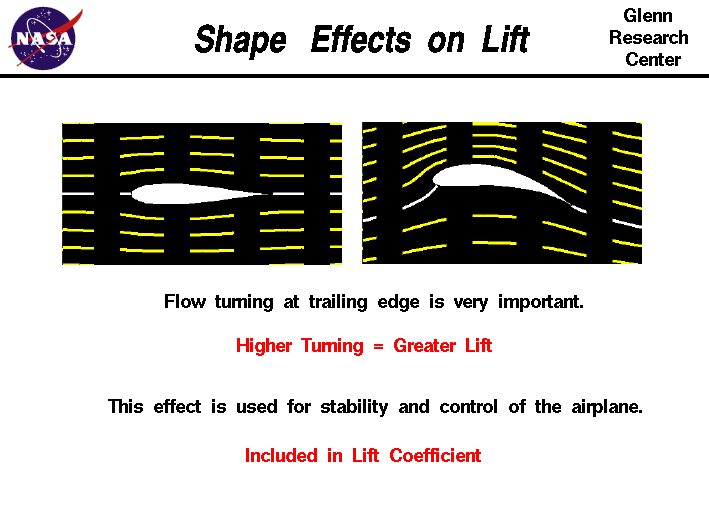
Interestingly, there are some production light planes that use older NACA wing sections designed for laminar flow but have relatively standard metal-wing structures. Some successful laminar-flow wings have been made with metal skins, but the amount of effort and weight needed to get the required surface condition and shape accuracy is very large. In practice this means that the wing will be heavier than one with a turbulent-flow airfoil and will probably have composite skins.
#Airfoil shape skin#
No oil canning, waviness or sagging of the skin like on fabric-covered wings is acceptable. This means that the skins of a laminar-flow wing must be formed to close tolerances and be quite stiff. If the wing skin has any waviness or bumps, it’s likely that laminar flow will be lost. Laminar flow requires that the airfoil maintain its shape to relatively tight tolerances. Having to make an emergency divert into an alternate airport due to low fuel if the airplane flies through a few bugs or rain is not acceptable.
#Airfoil shape full#
The designer must ensure that the airplane has sufficient fuel reserves to fly the full mission distance with this extra drag. The airplane will fly slower and its range will decrease. Not all laminar-flow section have this problem, but it must be considered in design.Įven if flying qualities are not adversely affected, losing laminar flow causes a significant increase in drag. Flying into even light rain caused a significant loss of lift on the foreplane, causing the airplane to nose down and require large up-elevator deflections to maintain level flight. This was a problem with some canard airplanes that used laminar-flow high-lift airfoils on the foreplane. Some extreme laminar-flow airfoils experience large losses of lift when the wing gets dirty. Most importantly, the airplane must retain safe flying qualities with a contaminated wing. Second, can the airplane successfully complete its mission if the wing becomes contaminated in flight? Even if the airplane is perfectly clean when it takes off, bugs, rain or light icing can cause a loss of laminar flow. An airplane operated in dirty conditions or that is stored outdoors on a tie-down is not likely to be kept as clean as needed. This sensitivity to contamination requires the designer to consider two things:įirst, is it reasonable to expect that the operator of the airplane can/will keep it clean enough so that the airplane is in a condition to have laminar flow in the wing when it is dispatched? Keeping the wings clean is a significant task. Contamination from dirt, bug strikes, water during flight in rain or even a very small amount of ice will trip the boundary layer and laminar flow will be lost. This sensitivity to protrusions also gives rise to one of the most serious considerations about using laminar-flow airfoils: The wing must be perfectly smooth.
#Airfoil shape free#
This means that the wing skin must be entirely free of protruding fastener heads or other similar features in the portion of the chord where laminar flow is expected. Protrusions and ContaminationĪny obstacle to the flow will trip the boundary layer. There have been cases where a spanwise paint stripe was enough to trip the boundary layer. This means it will not tolerate lap joints between metal skins or any skin joint that is not completely filled and faired. Laminar flow will also be tripped by any significant step protrusion or discontinuity in the skin. Any significant roughness will lead to premature transition to a turbulent boundary layer. In order to sustain laminar flow, the surface of the wing skin must be smooth.

Trying for the drag reduction of laminar flow is worthwhile for fast cross-country airplanes like this Lancair Legacy. Both the surface condition and the shape of the wing are critical to maintaining laminar flow. Laminar boundary layers are very sensitive and easily “tripped” into becoming turbulent. Attempting it imposes some significant requirements and restrictions on the airplane. This drag reduction is not easy to achieve.

The best laminar airfoils can have drag levels of about half that of airfoils with full-chord turbulent boundary layers. Airfoils designed to sustain laminar flow can have much lower parasite drag than turbulent-flow airfoils. They produce significantly less skin friction drag than turbulent boundary layers. Laminar boundary layers flow more smoothly over the skin than turbulent boundary layers. Once the flight conditions the airplane will operate at have been defined, and the designer knows what lift coefficient to optimize the airfoil choice at, it’s time to consider what type of airfoil to use.Īirfoils break down into two general classes based on the behavior of the boundary layer, which is the thin layer of air right next to the surface of the wing.


 0 kommentar(er)
0 kommentar(er)
